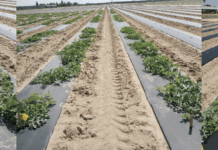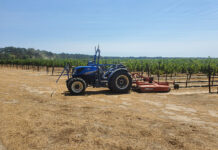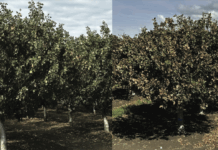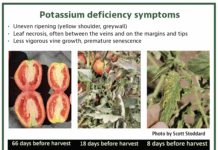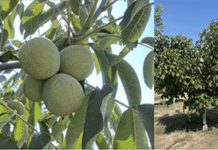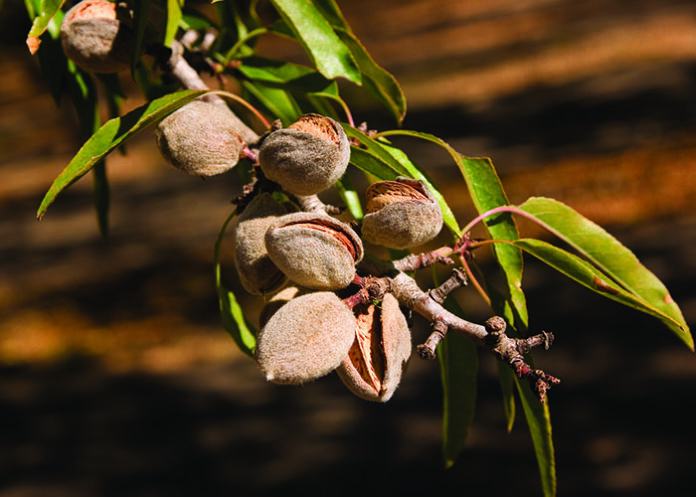Every season, crops must overcome environmental stressors from a range of biotic and abiotic conditions, including pest and pathogen pressure, drought, extreme weather or soil salinity. Abiotic stress alone can cause over 50% growth loss in most plant species, and disease pressure can cause even greater damage (Rejeb et al. 2014). Careful attention to crop protection and nutrition usually keeps crops healthy through periods of moderate stress, but with increasing production costs and tight regulations on ag chemical use, growers and consultants may benefit from additional materials to improve crop stress tolerance. Biostimulant products derived from natural plant compounds initiate defense mechanisms to control pests and pathogen pressure and protect against abiotic stressors (Shiade et al. 2024). All plants have evolved protective mechanisms to prevent damage from environmental stress, and by leveraging those innate processes with biostimulant applications, we can improve crop health and minimize stress symptoms. Understanding plant defense mechanisms and the biochemicals involved will help managers differentiate between biostimulants on the market and determine how to integrate them into standard crop management practices effectively.
The Four Stages of Plant Defense Mechanisms
Exposure to biotic or abiotic stress initiates defensive pathways that plants carry out in four stages: stress sensing, signal transduction, gene expression regulation and physiological adaptations to stress.
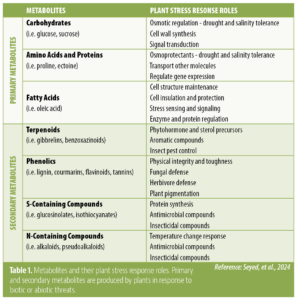
Stress detection
Immediately upon exposure to an environmental stressor, the plant must perceive the threat quickly to launch an effective defense. Plants identify stressors with molecular signal receptors, or by detecting other cellular changes caused by environmental conditions. Plants are equipped with many types of signal receptors to differentiate between individual threats in their environment. Stress is perceived when the sensory receptor binds with the threat signal molecule, causing a change in the receptor’s shape. Photoreceptors detect ultraviolet radiation and can trigger changes in growth according to light quality, intensity and duration. Hormone receptors and other types of molecular sensors can detect pathogens and pests or receive warning signals from soil microorganisms that initiate defense mechanisms (Shiade et al. 2024; Lal et al. 2023).
Plants also perceive stress when environmental conditions cause cellular changes, such as irregular ion flux or membrane fluidity. Increased calcium concentration and changes in osmolyte levels can indicate stress from drought, salinity or other adverse soil conditions. Cellular membrane fluidity fluctuates according to temperature, alerting cells to high heat or severe cold. These initial stress alerts trigger a defensive cascade that ultimately leads to genetic and physiological adaptations to protect the plant from the threat (Shiade et al. 2024).
Signal transduction
After the stressor is detected at the molecular level, the threat warning must be communicated within the cell, between cells and throughout the plant. Signal transduction pathways transmit the stress warning through a series of chemical reactions that result in genetic regulation and physiological changes. Several signal transduction pathways have been observed following stress exposure, and the type of response launched depends on the particular stressor perceived (Rejeb et al. 2014). Initial threat detection increases the concentration of signaling molecules and phytohormones such as reactive oxygen species (ROS), abscisic acid (ABA), salicylic acid (SA), jasmonic acid (JA) and ethylene (ET) that facilitate the defense response cascade. ROS rapidly increases in response to stress but serves different purposes for abiotic versus biotic threats. Pest and pathogen defense cascades are usually mediated by SA, JA and ET, while ABA directs abiotic stress defense (Shiade et al. 2024; Rejeb et al. 2014).
Gene expression regulation
Stress signal transduction often leads to changes in genetic expression that result in defensive biochemical or physiological changes within the plant. Stress signals are received by transcription factors (TFs) that can activate or suppress certain genes to adapt to environmental stress. Researchers have identified several pathogen-related (PR) genes and proteins that induce resistance to fungal and bacterial infection. Some PR genes, such as the Botrytis Susceptible (BOS1) gene, offer both biotic and abiotic defense. Upon activation. BOS1 induces resistance to necrotrophic pathogens and provides protection from osmotic stress (Rejeb et al. 2014). PR genes are normally activated by pathogen attack perception, but sometimes abiotic stressors can upregulate the pathogen defense genes. Cold stress triggers an accumulation of TFs that upregulate expression of certain PR genes in addition to genes involved in cold protection (Rejeb et al. 2014).
Physiological change
Stress signaling and genetic regulation result in physiological changes that defend the plant against the stressor. Stress response signaling leads to biopesticide production, cell wall reinforcements and other measures to prevent damage from environmental stress (Rejeb et al. 2014). For example, plants respond to drought stress by closing stomata and producing osmoprotectant compounds to conserve water. Rice plants prevent damage from soil salinity by increasing proline and other compounds that relieve osmotic pressure and toxicity (Shiade et al. 2024). Many other plants have similar adaptations to mitigate salinity and other adverse soil conditions. Plants confronted with pathogen pressure produce antimicrobial compounds and strengthen cell walls to deter attackers and prevent further infection (Shiade et al. 2024).
Leveraging Plant Stress Responses with Biostimulants
Plant stress defense researchers have identified many biochemicals that are critically responsible for protective mechanisms. These biochemicals include primary and secondary metabolites produced by plants in response to biotic or abiotic threats. Studies show that many metabolites offer stress protection when applied to crops as biostimulants or biopesticides. Integrating biologically based materials into standard crop management practices can improve pest control efficacy and maintain plant health under stressful environmental conditions (Lal et al. 2023; Shiade et al. 2024; Rejeb et al. 2014).
Primary metabolites
Primary metabolites (PMs), critical to plant growth and development, include carbohydrates, amino acids, proteins, and lipids. They provide the plant’s energy source and act as building blocks for macromolecules and cellular structures. PMs can also aid in stress defense by detecting threats, serving as signaling molecules, regulating osmotic potential and more. Carbohydrates including oligosaccharides, disaccharides and fructans accumulate in response to drought or salinity and alleviate stress through osmotic regulation. The protein proline also offers drought protection in addition to other functions, including pH buffering, protein structure stabilization and ROS scavenging. Lipids play important roles in stress perception and signaling, such as detecting changes in membrane fluidity due to extreme shifts in temperature. Many lipids also serve as the precursors necessary to build secondary metabolites critical to plant defense (Shiade et al. 2024).
Secondary metabolites
Secondary metabolites (SMs) include tens of thousands of biochemicals responsible for a wide range of functions, including enzyme regulation, signaling within and between cells, communication with soil microorganisms and more. SMs are categorized into four groups: terpenoids, phenolics, sulfur-containing compounds and nitrogen-containing compounds. SMs play crucial roles in plant defense mechanisms, and many of these compounds effectively reduce stress symptoms when applied as biostimulants (Shiade et al. 2024).
Terpenoids are the most abundant group of SMs, carrying out many functions, such as growth regulation, pollinator attraction and plant defense. The terpenoid JA is a critical signaling molecule that activates defense genes to protect plants again pathogens (Rejeb et al. 2014). Many other terpenes are precursor molecules for phytohormones required to deter pests or protect against other stressors (Shiade et al. 2024).
Many phenolic compounds, such as courmarins, tannins, salicylic acid (SA) and lignin, have been identified as effective biostimulants for both biotic and abiotic stress prevention (Lal et al. 2023). Coumarins help provide protection against pathogenic fungi and herbivorous pests. Another phenolic, lignin, toughens cell walls and provides physical protection against biotic and abiotic stress. Several types of tannins serve as natural pesticides by killing or repelling insects and pathogens. SA primarily serves in pathogen and pest defense signaling but can also mitigate drought and other abiotic stressors (Banothu and Uma 2021). SA treatments provide resistance against sheath blight and other fungal pathogens in several crops. SA has also been shown to prevent drought stress in corn and mitigate toxicity from the heavy metal cadmium in Triticum aestivum (Lal et al. 2023.)
The S- and N-containing compounds comprise a smaller set of secondary metabolites, but research shows several promising candidates for agricultural use. The S-containing compounds, including glucosinolates and related compounds, are found in brassicas and certain flowering plants. Foliar application of glucosinolate has been shown to control aphids on tomatoes and Spanish broom plants and may offer protection against other pests and pathogens on a variety of crops (Shiade et al. 2024).
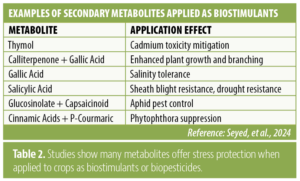
Integrating Biostimulants into Standard Management Practices
Independent research at universities and biotech labs around the world corroborate biostimulant efficacy in crop protection and stress prevention. Many metabolites offer protection against both biotic and abiotic threats, while others offer protection against specific stressors. Plant species differ in their defense capabilities, so some metabolites may work well on some crops, but not others. Similarly, some antimicrobial compounds control a specific group of fungal or bacterial pathogens, while others offer control over a broad spectrum of organisms. Further research will improve our understanding of the circumstances best suited to various metabolites, but learning about the active ingredients in biostimulants already on the market will help growers and consultants determine the crops and field conditions most likely to benefit from application. Although biostimulants might not replace conventional crop protection products, they offer a valuable tool to enhance crop stress tolerance and improve fertilizer and pesticide efficiency.
References
Lal, M. K., Tiwari, R. K., Altaf, M. A., et al., 2023. Editorial: Abiotic and biotic stress in horticultural crops: insight into recent advances in the underlying tolerance mechanism. Frontiers in Plant Science. 14:1212982.
Rejeb, I.N., Pastor, V., Mauch-Mani, B., 2014. Plant Responses to Simultaneous Biotic and Abiotic Stress: Molecular Mechanisms. Plants. 3, 458-475.
Shiade, S. R. G., Zand-Silakhoor, A., Fathi, A., et al., 2024. Plant metabolites and signaling pathways in response to biotic and abiotic stress: Exploring bio stimulant applications. Plant Stress. 12, 100454.
Banothu, V., Uma, A., 2021. Chapter: Effect of Biotic and Abiotic Stresses on Plant Metabolic Pathways. Intech Open.


